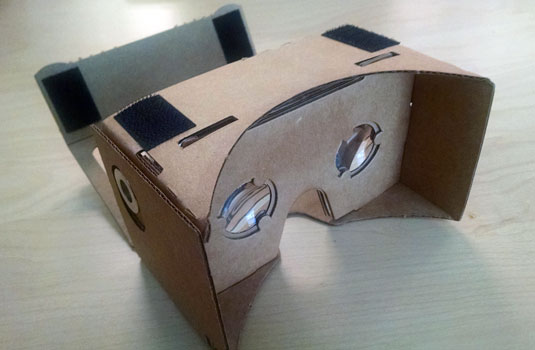This article is more than 1 year old
Google's Oculus-defying VR headset is made of CARDBOARD – no joke
DIY virtual reality for the masses (if you don't mind headaches)
Google I/O Among the other announcements at the Google I/O conference in San Francisco this week, the Chocolate Factory says it's moving into virtual reality – albeit in a decidedly low-fi way.
Attendees of the Wednesday morning I/O keynote each received a free VR headset called Cardboard – so named because it is, in fact, made out of brown cardboard plus a few other bits, including a pair of lenses, some Velcro, and a couple of magnets.
In other words, Oculus Rift it ain't. But the idea, which originated as a "20 per cent" project by French Googlers David Coz and Damien Henry, is for developers to be able to easily prototype VR projects without investing in expensive hardware.
Most of the heavy lifting is handled by the Cardboard app, a 188MB download that works on any phone running Android 4.1 or later. With the app installed, you can place the phone inside Cardboard, close it up using the attached Velcro tabs, and an NFC tag inside the box automatically launches the app.

Child's toy or a sophisticated VR peripheral? You decide
The lenses in the front then allow you to view stereoscopic animations that move based on the phone's sensors, so that when you tilt your head your vision pans around a virtual environment. A pair of magnets on one side of the box work with the phone's magnetometer to act as a button for clicking on things.
That's the idea, at any rate. When we tried it with a Moto X, the graphics were a blurry mess that made our eyes cross and the magnet-button didn't seem to do anything. Your mileage may vary – and if you weren't on hand at Google I/O to pick up Cardboard, there are full instructions available for you to build one yourself.
The Cardboard Android app comes with a variety of demo applications, including a Google Earth flyover, a VR-enabled Street View demo, and a 360-degree video viewer, among others. But the idea is for developers to write their own VR apps using the accompanying software VR Toolkit, which was also released on Wednesday.
"We're keeping the hardware and software open to encourage community participation and compatibility with VR content available elsewhere," Google's VR Toolkit developer page explains.
What's more, if you're particularly keen on the idea of homemade VR and want to discuss it with others, there is (naturally) a Google+ community for that. ®
